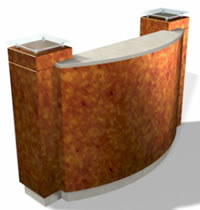Building a Curved Reception Desk
A quick run-down on creating curved cabinetry. September 26, 2009
Question
I have been asked to build a curved reception desk for a friend who is opening a new hair salon. This will be my first experience at building a curved desk. I have a fair bit of experience building traditional kitchen cabinets. What material should I use to construct the frame? The desk will be covered with either laminate or veneer. I was thinking laminate because she wants a pattern to show on the front of the desk, like quarter circles. The other option is to use veneer and stain the quarter circles to match her design.

Forum Responses
(Cabinetmaking Forum)
From contributor G:
Outwater has what you need. Kerfcore or Ultralite.
From contributor N:
Use 3/4" plywood for top and bottom plate with intermediate supports, and apply 2 layers of 3/8" bending plywood to face (radius). To veneer the curve, apply transparent packing tape to veneer so you can see and align your seam.
From contributor T:
We do a lot of curved reception desks. The way I would do it is 3/4" top and bottom cut to the shape of the radius. Verticals every 12" or so. Skin with 2 layers of bending luan on the face, 2 layers on the back. Make sure you glue the ribs to the face and use a roller to cover the second layer of bender to get good coverage.
From the original questioner:
I was originally thinking of going with horizontal pieces, but you suggested vertical ribs. You also said that you glue the luan to the ribs. Do you use any other fasteners? What type of glue do you use? Do you apply the veneer before or after the front is assembled?
From c contributor B:
The ribs are just like studs in a wall except 3/4" ply. You have a top and bottom plate that establish your radius. You attach the ribs to the plates. Glue (white) and staple the bending luan to the outside of the ribs, use regular ply on the straight parts. Make sure to drill holes in the ribs to allow for wiring. Make removable access panels on the inside of the diewall to get to the wiring.
I would use 1/8" MDF as the top layer on the outside of the radius to get a smoother surface for gluing the veneer to the diewall because the bending ply is too rough and could telegraph any imperfections in the ply.
